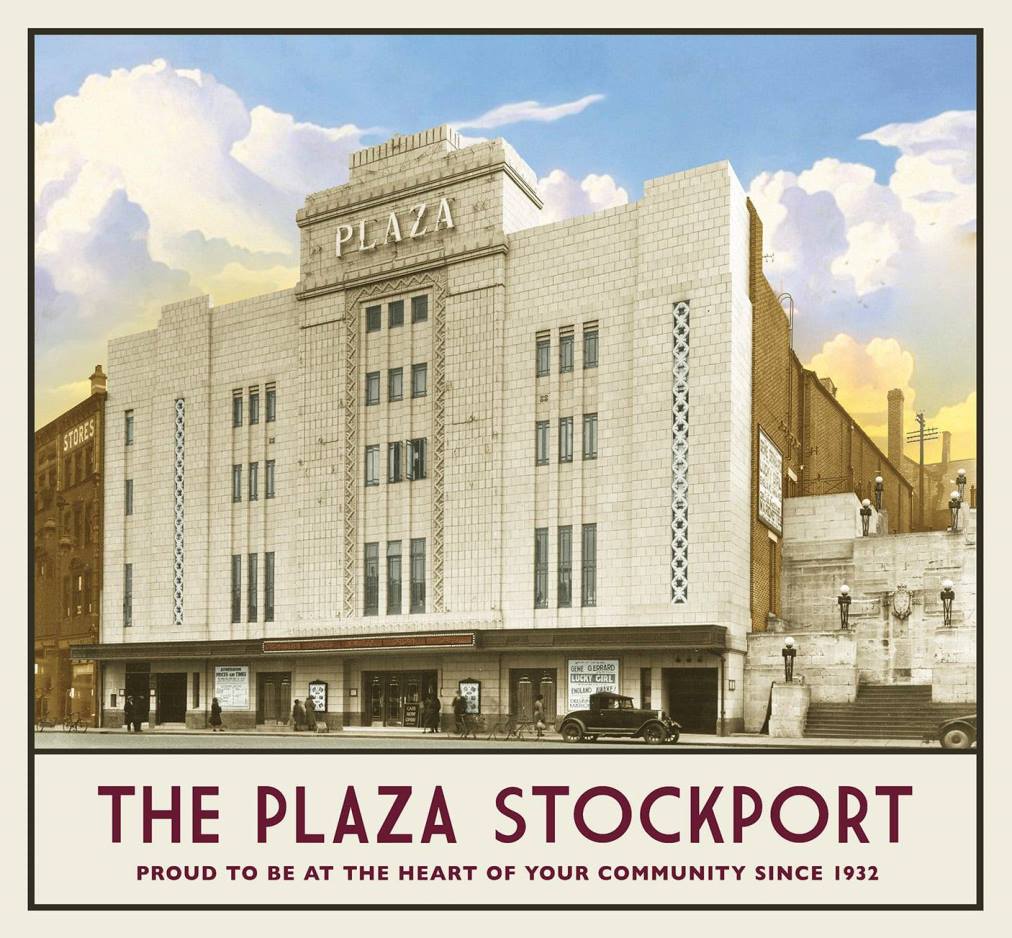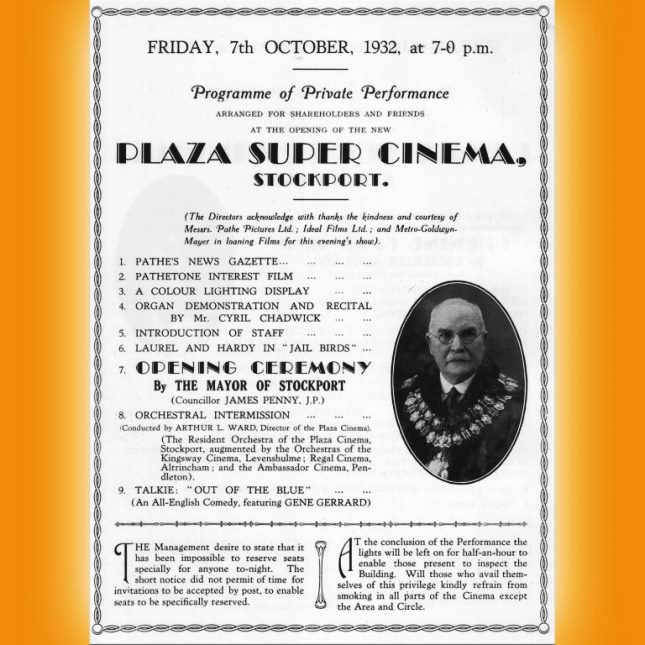Ted Doan
The Plaza has always been much more than a cinema. It has offered style and glamour as well as a variety of entertainment to many generations of young Stopfordians. As such it needed a showman to tell its story and, with Ted Doan, that is exactly what we got. Ted regaled us for an hour with stories and anecdotes about the history of the Plaza, intertwined with his own career, all without a ubiquitous PowerPoint presentation and with not a note in sight. However, as Ted reminded us several times, “Never let the truth get in the way of a good story”, so this report should be read with that in mind.

It was conceived at the start of the great age for cinemas, the nineteen thirties, but from the outset it was head and shoulders above its contemporaries. The initial plans incorporated a motor garage, a billiard hall and a restaurant, all above a 1650 seat cinema. The site in Mersey Square was ideal and several cinema owners who had come together to build the Regal Cinema in Altrincham created a consortium and modified the original plans, eliminating things such as the motor garage and the billiard hall but increasing the seating to 1878 and incorporating the latest architectural trends and art deco designs. The most spectacular feature was the facade covered in bespoke white glazed tiles.
Stockport Super Cinemas History: Davenport - Essoldo - ABC Ritz - Super Cinema - Plaza Theatre
Before the construction of the Plaza, an elegant set of steps* connecting Mersey and St Peter’s Squares, were built by Stockport Corporation, in 1929. To make way for the Plaza, on a site adjacent to these steps, a row of cottages was demolished followed by the excavation of 10,000 tons of sandstone. The developers decided that local contractors were too expensive so they brought in building firms from Warrington and Liverpool which caused some ill feeling with local businesses and particularly the local paper. Nevertheless, when it opened on 7th October 1932 it was an enormous success. It had cost £47,000 (about £2.7 million in today’s values) and had all the latest equipment and a Compton organ that could be raised and lowered, together with fitted carpets, electric lighting and coloured neon decoration. For mill workers living in  Click to see larger imagecramped rented houses this was a fantasy world –– a place to escape to for a few hours, away from the reality of life.
Click to see larger imagecramped rented houses this was a fantasy world –– a place to escape to for a few hours, away from the reality of life.
The first shows were cine-variety but this soon changed to the familiar pattern of a feature film and a supporting ‘B’ film with an interval. The initial success of the Plaza attracted competition and by 1938 there were two more super-cinemas in the centre of Stockport , the Essoldo and the Ritz, and two in the suburbs, the Davenport and the Empress. Nevertheless the Plaza continued to prosper. During the Second World War the Plaza had a unique attraction being partly underground. It was regarded as one of the safer places during an air raid. However, when the war ended it suffered because, being independent, it could not get early-released films and people were looking elsewhere for entertainment. Despite this the Plaza tried to move upmarket by refurbishing, offering CinemaScope and staging variety acts and concerts but it was not enough. The building was sold to Mecca Bingo and the final show was on 31st December 1966. Despite initial resistance from Stockport Council, Mecca was able to get planning permission for Bingo and the first floor cafe was initially converted into Samantha’s Nightclub. That did not last and it was used for extra seating for the bingo. However, the enthusiasm for Bingo also faded with time and in 1999 Mecca sold the operation. However, by this time the Plaza had been designated Grade II by English Heritage on the grounds of its “remarkably lavish exercise in the Art Deco style. …..an exceptionally complete example of a 1930s ‘super cinema’ which survives little altered and retains its Compton organ.” The Plaza Steps next door to the cinema received the same designation.
Stockport Council was also keen to preserve it, not so much because of the architecture but because it was the last remaining building in Stockport capable of full-scale theatre and entertainment use. The Council agreed to buy the building from Mecca and because of its listed status it was purchased at below the commercial value. A charitable trust was set up to run the the theatre and an agreement was made that the trust would buy the building from the council after ten years, once it had proven it could run it at a profit. If not it would be sold on the open market. It might be a charitable trust but it had to be run professionally so several posts were filled by full time employees including our speaker who came in as general manager. Although he came from Torquay, the home town of Basil Fawlty, he managed to convince the appointment board that he would not use similar management methods.
The variety theatre reopened with the help of a large number of volunteers and local support. Ken Dodd, who had started his career in Stockport, agreed to be a patron and there was a lot of goodwill from the theatrical profession. At about this time the Davenport was closed and the trust acquired the frame mechanism for the stage. However, goodwill is not enough to pay for major restoration and it had been decided that it was necessary to repair the structure. The National Lottery offered the trust almost £2 million (after throwing out their first application and then helping them prepare a much more polished proposal.) However, the fly in the ointment was that the trust had to come up with matching funding. This was not the sort of money that could come from small scale fund-raising - they had to think big and the trust contacted a wide variety of enterprises, whether relevant or not. One such organisation, the North West Development Agency, was really responsible for economic development and regeneration, but they decided that support for theatres could be a legitimate activity and they offered a substantial share of the requisite funding. Only just in time as the agency was abolished in 2012.

Re-opening night - 12th January 2015
The restoration took place in 2009 and, like many of these major jobs, it had some nasty surprises. They found out why the builders from Warrington and Liverpool had been able to offer such low prices in 1932 - they had cut some very big corners. One of the walls had no foundations and in other parts they were inadequate. But at last the work was finished, the facade was improved and the Plaza could present a new face to the world. It is here to stay but only if it can attract customers so Ted made sure that everyone who wanted had a copy of the current season’s offerings.
He left us with a final thought. As a nod to tradition the audience are encouraged to stand before a performance while ‘God Save the King’ is played. Now, there’s an idea for our next meeting.
* The only set of steps in Stockport to have a listing grade
Further reading:
- Plaza Heritage Gallery
- Plaza Steps on Stepport
















